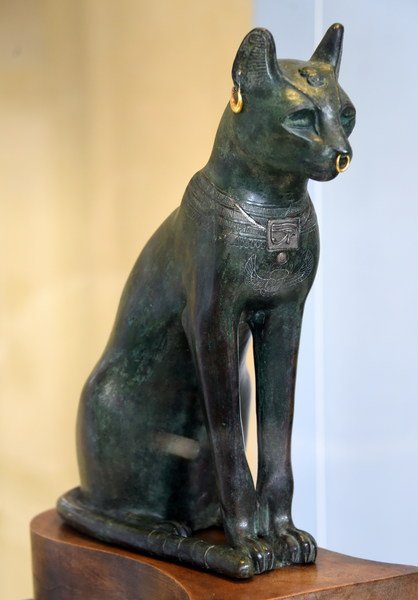In last week’s post about cat themed Halloween costumes, I included one costume representing the ancient Egyptian deity Bastet.
If you aren’t familiar with ancient Egyptians (spoiler alert – they loved cats) read on for a cliff notes version of a time when cats were truly idolized.
My Early Interest
I’ve been fascinated with ancient Egypt since I was a small child. I had a cigar box full of small stones carved into replica scarab beetles (see footnote) that I would collect from visits to art museums and knick-knack stores. And I would draw King Tut and the pyramids in art class alongside – of course – cats!
It wasn’t until my late 30’s that I finally made it to Paris to visit the Department of Egyptian Antiquities at the Louvre – which is probably the best way to view Egyptian artifacts if you can’t make it to Egypt proper. And within the department are many feline themed artifacts, including mummified cats as well as carved or painted depictions of Bastet.

So let’s get into what – and who – Bastet represented for the Egyptian people.
History of Bastet
Since I’m no historian, what follows is a well written summary courtesy of Joshua J. Mark, a freelance writer and former part-time Professor of Philosophy at Marist College, New York.
“Bastet was (and for some still is) the Egyptian goddess of the home, domesticity, women’s secrets, cats, fertility, and childbirth. She protected the home from evil spirits and disease, especially diseases associated with women and children. As with many Egyptian deities, she also played a role in the afterlife as a guide and helper to the dead although this was not one of her primary duties. She was the daughter of the sun god Ra and is associated with the concept of the Eye of Ra (the all-seeing eye) and the Distant Goddess (a female deity who leaves Ra and returns to bring transformation).
Bastet was extremely popular throughout Egypt with both men and women from the 2nd Dynasty (c. 2890 – c. 2670 BCE) onward with her cult centered at the city of Bubastis from at least the 5th century BCE. She was first represented as a woman with the head of a lioness and closely associated with the goddess Sekhmet but, as that deity’s iconography depicted her as increasingly aggressive, Bastet’s images softened over time to present more of a daily companion and helper than her earlier forms as savage avenger.
Although she was greatly venerated, she was equally feared as two of her titles demonstrate: The Lady of Dread and The Lady of Slaughter. She is associated with both Mau, the divine cat who is an aspect of Ra, and with Mafdet, goddess of justice and the first feline deity in Egyptian history. Both Bastet and Sekhment took their early forms as feline defenders of the innocent, avengers of the wronged, from Mafdet. This association was carried on in depictions of Bastet’s son Maahes, protector of the innocent, who is shown as a lion-headed man carrying a long knife or as a lion.
Her cult center at Bubastis in Lower Egypt became one of the richest and most luxuriant cities in Egypt as people from all over the country traveled there to pay their respects to the goddess and have the bodies of their dead cats interred in the city. Her iconography borrowed from the earlier goddess Mafdet and also from Hathor, a goddess associated with Sekhmet who was also closely linked to Bastet. The appearance of the sistrum in Bastet’s hand in some statues is a clear link to Hathor who is traditionally seen carrying the instrument. Hathor is another goddess who underwent a dramatic change from bloodthirsty destroyer to gentle friend of humanity as she was originally the lioness deity Sekhmet whom Ra sent to earth to destroy humans for their sins. In Bastet’s case, although she became more mild, she was no less dangerous to those who broke the law or abused others.
The popularity of Bastet grew from her role as protector of women and the household. As noted, she was as popular among men as women in that every man had a mother, sister, girlfriend, wife, or daughter who benefited from the care Bastet provided. Further, women in Egypt were held in high regard and had almost equal rights which almost guaranteed a goddess who protected women and presided over women’s secrets an especially high standing. Cats were also greatly prized in Egypt as they kept homes free of vermin (and so controlled diseases), protected the crops from unwanted animals, and provided their owners with fairly maintenance-free company. One of the most important aspects of Bastet’s festival was the delivery of mummified cats to her temple. When the temple was excavated in 1887 and 1889 CE over 300,000 mummified cats were found.”
Want to read more of Joshua’s work? Check it out here.
About Joshua J. Mark
A freelance writer and former part-time Professor of Philosophy at Marist College, New York, Joshua J. Mark has lived in Greece and Germany and traveled through Egypt. He has taught history, writing, literature, and philosophy at the college level.

